Dell XPS 410: Core 2 Duo for the Masses
by Jarred Walton on September 18, 2006 12:20 PM EST- Posted in
- Systems
Internals and Construction
The case design of the XPS 410 is really quite excellent, and many of the well-known case manufacturers could learn a thing or two about creating a tool-less case from it. All of the major components can be accessed quickly and easily without the use of a screwdriver, and we have to think that the assembly-line process at Dell factories is greatly enhanced by the design. After pushing the latch at the top-rear of the case back, the right side panel pops out and you gain access to the interior.
We were given a high-end configuration, complete with almost every accessory that most people would want. This has an interesting impact on the interior appearance, as you basically have a wide open middle section while the top and bottom of the case are more packed with components. The wiring isn't absolutely pristine like you might see in some of the higher end system integrator offerings, but most of the wires are secured at various points to keep them out of the way. Without a case window, we aren't too concerned about a few unsightly wires, and there's still plenty of open space allowing for ample air flow to keep your system interior cool.
At the bottom of the case are the two internal 3.5" drive bays, which are both occupied by 320GB 16MB cache Western Digital drives in our system. Both drives reside in plastic sleds that can be easily removed, but the drives themselves are secured to the sleds with standard screws. Dell set up our drives in a RAID 1 configuration, which will help protect users from data loss and downtime due to a failed hard drive. RAID 1 is not generally considered a backup solution, as it doesn't protect you from accidentally deleted files, viruses, or data corruption issues that might occur, but as a means of improving uptime it is definitely useful. If you need more storage capacity, you can opt for larger drives and/or omit the RAID 1 configuration (or perhaps go with RAID 0 for enhanced performance at the cost of reliability). If you want to add more than two hard drives, you could use the 3.5" or 5.25" external bays (with an adapter for the 5.25" bays).
The 375W power supply had no problems running our test configuration, which is basically loaded up with most of the high-end features you might want to add. A third or fourth hard drive would use a bit more power, as would larger drives, but even if you filled every available expansion slot it would be difficult to overload the power supply with current components. The story might change in the future with the release of the next-generation video cards from NVIDIA and ATI, unfortunately, so in the long term the PSU may prove insufficient. Most people don't generally buy Dell computers for their extensive upgrade capability, so this probably isn't a major concern for them. On the other hand, those who might want a G80 or R600 could very likely find themselves in need of a higher performance PSU.
That brings up another point that's important to mention. In the past, Dell has been somewhat notorious for including proprietary power connectors and motherboard designs. Starting about a year ago, all motherboards should now be using a standard 24-pin ATX power connector with an additional 4-pin ATX 12V connector. It was possible to get adapters in the past that would allow the use of a generic power supply, but this is now unnecessary. If you decide that you want something better than the standard 375W power supply in the future, it should not be at all difficult to replace the power supply. It would still be better to get a higher capacity power supply in the first place, especially given the price of the system, but as stated the 375W power supply should be sufficient for the vast majority of users.
We spoke earlier about the expansion card slots and the tool-less mechanism that is used to secure them. You can see a close-up shot of this area in the above pictures. First, you have the main blue latch that helps hold all of the expansion cards in place, and it also provides for some cable routing. This latch snaps into the bottom of the CPU heatsink duct. At the back of the case, you have a hinged clamp that holds all of the expansion brackets in place, and there are slight protrusions that slip into the screw notches in order to fully secure the cards. Opening the hinge is accomplished by pressing the two small "buttons" and then the whole door swings open. The whole system is extremely slick, and we would really like to see something similar make its way into standard ATX cases. It's almost a shame that most people that purchase an XPS 410 are unlikely to appreciate the ease with which the system can be upgraded.
It is extremely easy to access all the components within the XPS 410. The most difficult component to replace is the CPU, and event that task is relatively simple. Two screws are used to secure the plastic duct that also holds the heatsink in place. Loosen those two screws, gently pull back on the CPU duct, and it should come loose giving access to the CPU socket. While the Dell heatsink isn't the largest we have seen, considering that there are no overclocking options on the system and that Dell doesn't ship the XPS 410 with the X6800 processor and the cooling solution should be more than sufficient. Future upgrades to quad core CPUs should also work, provided Dell releases an appropriate BIOS update.
One item of interest is the optical drives that Dell includes. The system is entirely legacy free, which means there are no PS/2 ports, no serial ports, no parallel port, and with the use of the ICH8 Southbridge, there are no IDE ports either. There are six SATA ports, four of which are occupied in our configuration. Two of these are used for hard drives, while the other two are used for the optical drives. Dell includes a Toshiba TS-H553 16X DVD-RW for burning/backup duties, while a Philips DVD-ROM (a rebranded BenQ) serves as a second optical drive. Extensive testing of the DVD burner capabilities is beyond the scope of a system review, but we were able to burn and read a couple DVDs without issue. Both optical drives are average in terms of noise levels, which means at maximum speed they are actually louder than anything else inside the system. Luckily, optical drives don't need to run continuously. Unfortunately, SATA optical drives currently cost more than IDE optical drives, which likely adds an extra $50 or so to the system price.
Accessing the drive bays is once again an exercise in convenience. All you have to do is press down on the blue locking mechanism, and that will release the front cover and allow you to slide out any of the drives. The drives use screws as a sort of mounting rail, so if you want to replace a drive you will have to break out a screwdriver, but if you just need to temporarily remove the drives the process is very simple.
The case design of the XPS 410 is really quite excellent, and many of the well-known case manufacturers could learn a thing or two about creating a tool-less case from it. All of the major components can be accessed quickly and easily without the use of a screwdriver, and we have to think that the assembly-line process at Dell factories is greatly enhanced by the design. After pushing the latch at the top-rear of the case back, the right side panel pops out and you gain access to the interior.
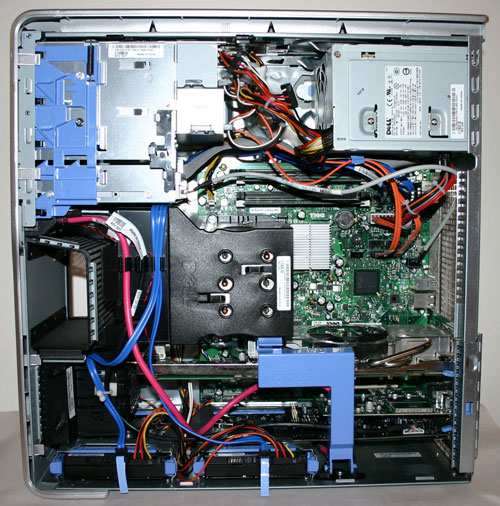 |
| Click to enlarge |
We were given a high-end configuration, complete with almost every accessory that most people would want. This has an interesting impact on the interior appearance, as you basically have a wide open middle section while the top and bottom of the case are more packed with components. The wiring isn't absolutely pristine like you might see in some of the higher end system integrator offerings, but most of the wires are secured at various points to keep them out of the way. Without a case window, we aren't too concerned about a few unsightly wires, and there's still plenty of open space allowing for ample air flow to keep your system interior cool.
 |
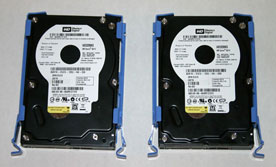 |
| Click to enlarge | |
At the bottom of the case are the two internal 3.5" drive bays, which are both occupied by 320GB 16MB cache Western Digital drives in our system. Both drives reside in plastic sleds that can be easily removed, but the drives themselves are secured to the sleds with standard screws. Dell set up our drives in a RAID 1 configuration, which will help protect users from data loss and downtime due to a failed hard drive. RAID 1 is not generally considered a backup solution, as it doesn't protect you from accidentally deleted files, viruses, or data corruption issues that might occur, but as a means of improving uptime it is definitely useful. If you need more storage capacity, you can opt for larger drives and/or omit the RAID 1 configuration (or perhaps go with RAID 0 for enhanced performance at the cost of reliability). If you want to add more than two hard drives, you could use the 3.5" or 5.25" external bays (with an adapter for the 5.25" bays).
The 375W power supply had no problems running our test configuration, which is basically loaded up with most of the high-end features you might want to add. A third or fourth hard drive would use a bit more power, as would larger drives, but even if you filled every available expansion slot it would be difficult to overload the power supply with current components. The story might change in the future with the release of the next-generation video cards from NVIDIA and ATI, unfortunately, so in the long term the PSU may prove insufficient. Most people don't generally buy Dell computers for their extensive upgrade capability, so this probably isn't a major concern for them. On the other hand, those who might want a G80 or R600 could very likely find themselves in need of a higher performance PSU.
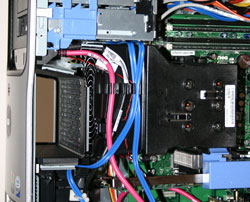 |
| Click to enlarge |
That brings up another point that's important to mention. In the past, Dell has been somewhat notorious for including proprietary power connectors and motherboard designs. Starting about a year ago, all motherboards should now be using a standard 24-pin ATX power connector with an additional 4-pin ATX 12V connector. It was possible to get adapters in the past that would allow the use of a generic power supply, but this is now unnecessary. If you decide that you want something better than the standard 375W power supply in the future, it should not be at all difficult to replace the power supply. It would still be better to get a higher capacity power supply in the first place, especially given the price of the system, but as stated the 375W power supply should be sufficient for the vast majority of users.
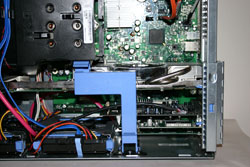 |
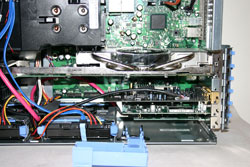 |
| Click to enlarge | |
We spoke earlier about the expansion card slots and the tool-less mechanism that is used to secure them. You can see a close-up shot of this area in the above pictures. First, you have the main blue latch that helps hold all of the expansion cards in place, and it also provides for some cable routing. This latch snaps into the bottom of the CPU heatsink duct. At the back of the case, you have a hinged clamp that holds all of the expansion brackets in place, and there are slight protrusions that slip into the screw notches in order to fully secure the cards. Opening the hinge is accomplished by pressing the two small "buttons" and then the whole door swings open. The whole system is extremely slick, and we would really like to see something similar make its way into standard ATX cases. It's almost a shame that most people that purchase an XPS 410 are unlikely to appreciate the ease with which the system can be upgraded.
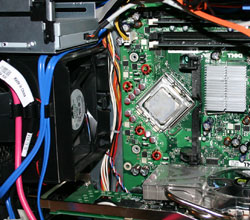 |
 |
| Click to enlarge | |
It is extremely easy to access all the components within the XPS 410. The most difficult component to replace is the CPU, and event that task is relatively simple. Two screws are used to secure the plastic duct that also holds the heatsink in place. Loosen those two screws, gently pull back on the CPU duct, and it should come loose giving access to the CPU socket. While the Dell heatsink isn't the largest we have seen, considering that there are no overclocking options on the system and that Dell doesn't ship the XPS 410 with the X6800 processor and the cooling solution should be more than sufficient. Future upgrades to quad core CPUs should also work, provided Dell releases an appropriate BIOS update.
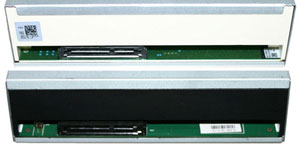 |
 |
| Click to enlarge | |
One item of interest is the optical drives that Dell includes. The system is entirely legacy free, which means there are no PS/2 ports, no serial ports, no parallel port, and with the use of the ICH8 Southbridge, there are no IDE ports either. There are six SATA ports, four of which are occupied in our configuration. Two of these are used for hard drives, while the other two are used for the optical drives. Dell includes a Toshiba TS-H553 16X DVD-RW for burning/backup duties, while a Philips DVD-ROM (a rebranded BenQ) serves as a second optical drive. Extensive testing of the DVD burner capabilities is beyond the scope of a system review, but we were able to burn and read a couple DVDs without issue. Both optical drives are average in terms of noise levels, which means at maximum speed they are actually louder than anything else inside the system. Luckily, optical drives don't need to run continuously. Unfortunately, SATA optical drives currently cost more than IDE optical drives, which likely adds an extra $50 or so to the system price.
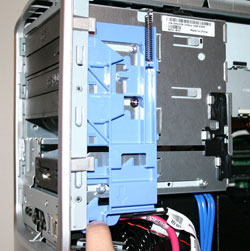 |
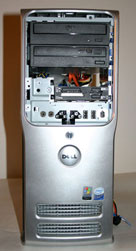 |
| Click to enlarge | |
Accessing the drive bays is once again an exercise in convenience. All you have to do is press down on the blue locking mechanism, and that will release the front cover and allow you to slide out any of the drives. The drives use screws as a sort of mounting rail, so if you want to replace a drive you will have to break out a screwdriver, but if you just need to temporarily remove the drives the process is very simple.










50 Comments
View All Comments
JarredWalton - Tuesday, September 19, 2006 - link
No problem - gotta do my job as author! :)You might want to email Gary on the HDD stuff, as that's basically beyond the scope of system testing. He's handling HDD reviews, so maybe you can pass on your suggestions. I think he's covered HDD performance well, though getting repeatable results with real world tests is going to be somewhat difficult.
JarredWalton - Monday, September 18, 2006 - link
^^ Er..."defragment" not "the fragment"
*EIGHT* thousand words, not "a thousand".
LOL Stupid Dragon NaturallySpeaking! (Stupid editor for not proofing my post before hitting reply.)
biggersteve - Monday, September 18, 2006 - link
An amazing story. XPS has a special support number 800-999-3355. We called this number and the guy in India was pretty efficient and helpful. XP had died with a reboot loop. Could not even safe boot. The guy advised us to use ctl-F11 to completely erase the HD and start over. We'd only had it a week so that was ok, though I suspect we could have done a roll-back, though we couldn't even safe boot. Anyway, all this happened after Microsoft helpfully installed 37 automatic updates. The guy at Dell said half the calls they're getting are because of this. (The other half must be the battery recall...) So he told us to turn off Windows Automatic Updates and never ever ever use it again. I only have one data point, but it looks like Microsoft released an automatic update that whacks all the XPS 410's out there and maybe more. So now we have a standoff where Dell is telling everyone to never use Microsoft automatic updates. Who wins? The virus and spyware writers. And Apple... since Apple controls the hardware and OS alike, they'd never release a cluster-fsck like this one.yyrkoon - Monday, September 18, 2006 - link
well, this should be obvious, but the person who told you to turn off windows automatic updates, and to 'never ever ever turn it on again' is an idiot. Sounds like either you had/ have spyware, or a virus, OR, you installed a hardware update from MS, instead using Dells drivers. I have personally run into 'MS certified drivers' issues with Dell systems in the past (more than once). I dont own a Dell myself, but the majority of our customers, that want a prebuilt in-expencive systems, we recommend to buy from Dell, so we do see our share of them.My recommendation, would be to USE automatic updates, but instead of having it download, and install the updates for you, configure it to notify you only, then you can manually download, and install yourself. When installing the updates, make sure to choose 'custom', and read what each update is all about. 9 times out of 10, if it isnt a critical update, or a security fix, you dont need it.
mino - Tuesday, September 19, 2006 - link
Agreed on the auto-off stuff.However it is possible some MS priority update will not like some HW/drivers even WHQL-ed ones. Compatibility is the word. Windows world is simply too diverse to check all of the possibilities.
mino - Monday, September 18, 2006 - link
Experienced such a story many times... SP2, .NET 2.0, specific "hot-fix" ...Cynic would say "Welcome to the world of Windows!". ;(
JarredWalton - Monday, September 18, 2006 - link
Interesting. I did download and apply all of the currently available patches from Microsoft without any problems. Note that I downloaded these manually rather than letting Windows do the patch automatically during the night. I don't know if that would make a difference, but I don't particularly like having the automatic update process running all the time.mino - Tuesday, September 19, 2006 - link
Most of the times things work, the problem are the situations when they do not.Not once have I had to spend a day installing a few updates a time, just to find out which one was incompatible .. so that some Windows feature would work.
Pastuch - Monday, September 18, 2006 - link
I am actually a Dell employee at their technical support centers in Ottawa Ontario Canada. I can say with all honesty that if you get anyone in north america youll probably get great support. The problem is that Dell phone support has a large number of different queues and our customers tend to get bounced around quite a bit. The company is really trying to improve their customer service which is why they have moved most of their tech support to Canada. If you know someone that isnt tech savy they have the option of buying a "Dell on Call" plan. This is an annual plan or single incident that provides support for pretty much anything. If you are going to get a Dell you can get a 30day trial of DOC (Dell on Call) support with your system. A typical DOC call will have the agent remotely connect to your computer and show you the basics of spyware/adware prevention, updates, system maintenance , etc. I have been an Anand reader for years and I think the type of people likely to buy this PC would benefit from Dell on Call software support. I actually worked in DOC for the last 6 months and was resently promoted to IT operations for the building here in Ottawa.For the record: I've never bought a dell and I'll continue to build all my PCs from scratch and overclock the $hit out of them. Nothing like taking an Opteron 146 (2.0) to 2.8 on AIr!
P.S. In the next year you will be able to get almost any of our machines with AMD or Intel chips. I was one of the thousands of Dell employees that have been pushing for this for a long time. ;)
regpfj - Monday, September 18, 2006 - link
To Jarred - great review, nice job. I liked the discussion of the case features and proprietary motherboard. It's fun to see a legacy-free setup, although serial and IDE have their place too. These unusual things make Dell stuff a bit more interesting to read about.On to my question -
On page 9, the fps vs resolution graphs confused me a tiny bit. For all games except Bf2, performance is a bit lower at 1600 x 1200 than at 1680 x 1050. I think 16x12 is about 9% more pixels than 16.8 x 10.5, right? So is Bf2 just weird, or did the numbers get turned around a bit?